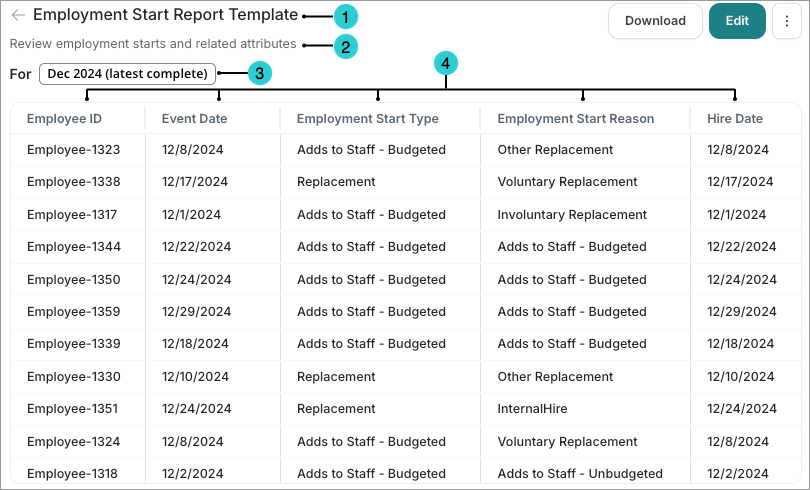Reports
Leverage reporting to present data in a clear and actionable way.
Who can use this feature?
- This is available to Embedded Partners
Not sure if you have this feature or capability? Reach out to your administrator.
Overview
Reports are a powerful tool that allow you to efficiently collect, organize, and present data in a clear, tabular format. The ability to generate customizable reports enhances collaboration and transparency across teams. Reports work with Visier's security model to ensure users only see data they are permitted to see. The data security context of the user is applied when they are working with reports.
Reports are categorized as either versioned or non-versioned. For more information, see Create a Report.
- Versioned reports are created by administrators in a project and published to all users with Reports access.
- Non-versioned reports are created in the Reports room and can be shared with individual users and user groups.
To align with your application's branding, you can customize the appearance of the Reports room, including its typography, color, and border radius. For more information, see White Label Visier.
Manage Reports
The Reports room is where you can create and manage your reports.
Who can use this feature?
Users can view the Reports room with this permission capability:
- View Report
Users can view, create, modify, and delete reports with this permission capability:
- Write Report
Not sure if you have this feature or capability? Reach out to your administrator.
In Reports, you'll find a list of the reports you can access, as shown in the following screenshot.

- Search: Find a report by typing the report title, description, or the owner's name.
- List view options: Switch between the tabs to view a list of all reports you have access to, reports that are owned by you, reports that have been shared with you, and versioned reports that are published to production. To customize the display text and visibility of the Owned by me, Shared with me, and Published tabs, see Functional customization objects.
- Create report: Create a new report from scratch. For more information, see Create a Report.
- Quick Actions toolbar: Hover over a report to duplicate, delete, and share it.
Note: Users must also have the Share Analysis capability to share reports with other users.
To access Reports, on the navigation bar, click Reports ![]() .
.
Report templates
Report templates are created by Visier experts as part of the Visier Blueprint. The content within the templates is designed to serve as a reference for administrators to explore and validate data to include in reports. Additionally, they allow for customization and adaptation of report designs to fit specific use cases. Administrators can easily manage templates as versioned reports, which can be published as templates for users or used as standard reports. For more information about content inheritance, see "Content hierarchy" in Tenant Hierarchy and Blueprint Inheritance.
To see your report templates, open a project and navigate to Model > Reports.
You can customize a report template by duplicating it. In the Reports list, select the report template you want to customize, and then click the More options button ![]() > Duplicate. You can edit the duplicated report to customize it.
> Duplicate. You can edit the duplicated report to customize it.
Note: Access to report templates is managed via modules. Different template types are available within specific modules, and administrators can use this same method to deliver tailored reports to their users. For more information, see "Defining modules" in Content Strategy Embedded Best Practices.
Report templates generally follow a simple design framework, illustrated by the following example.

- Title: Subject or Event the report is based on Report Template
- Description: Review Subject or Event the report is based on and related attributes.
- Time picker: Set to update automatically to latest complete time period.
-
Columns: Start with the key that represents each individual row. For example, if subject-based, then Subject ID, if event-based, then Subject ID and Event Date. The rest of the attributes are listed in alphabetical order. Columns are organized in alphabetical order so you can easily evaluate the columns you want to keep, exclude, or reorder to address your specific use case.
Note: Date data types are displayed in a long format by default, for example Dec 13, 2024. To use numerical formatting, such as 12/13/2024, contact Visier Technical Support to enable this feature.
Additional design elements:
- Suggestions: A small selection of key subject references are configured as suggestions for both columns and group bys to highlight for report users.
- Filters and group bys: These are intentionally not set so report users can customize them.
- Aggregation functions: All report templates have a Count aggregation set for Subject ID columns. This helps highlight that aggregation functions are available when report users add a group by dimension. Aggregation functions are not visible to users until a group by is applied to the report. Some columns will have a Sum aggregation set, as these columns often benefit by reporting on the sum grouped by a specific dimension for a more high level view of the data. For example, Actual Base Pay.
